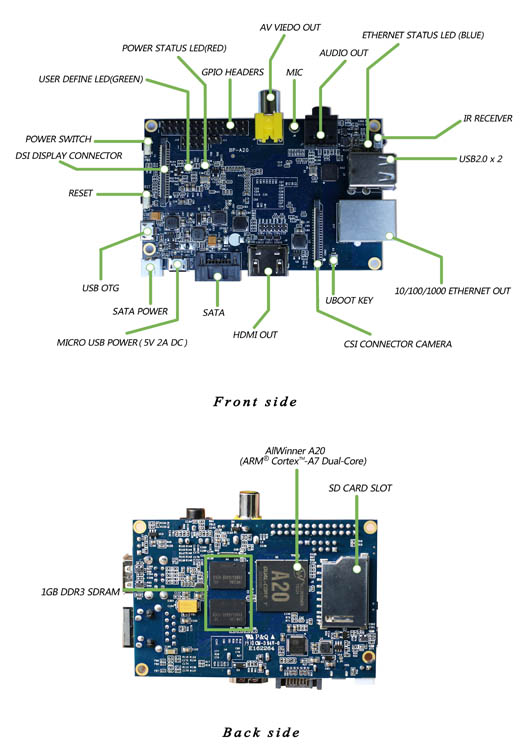Banana Pi: Difference between revisions
No edit summary |
No edit summary |
||
| Line 3: | Line 3: | ||
== Description == | == Description == | ||
[[File:Banana pi back.jpg]] | |||
It’s an open-source single-board computer. It can run Android 4.4, Ubuntu, Debian, Rasberry Pi Image, as well as the Cubieboard Image. It uses the AllWinner A20 SoC, and has 1GB DDR3 SDRAM. Banana Pi is for anyone who wants to start creating with technology – not just consuming it. It's a simple, fun, useful tool that you can use to start taking control of the world around you. | It’s an open-source single-board computer. It can run Android 4.4, Ubuntu, Debian, Rasberry Pi Image, as well as the Cubieboard Image. It uses the AllWinner A20 SoC, and has 1GB DDR3 SDRAM. Banana Pi is for anyone who wants to start creating with technology – not just consuming it. It's a simple, fun, useful tool that you can use to start taking control of the world around you. | ||
| Line 10: | Line 11: | ||
CPU: A20 ARM® Cortex™-A7 Dual-Core | CPU: A20 ARM® Cortex™-A7 Dual-Core | ||
GPU: ARM Mali400MP2 Complies with OpenGL ES 2.0/1.1 | GPU: ARM Mali400MP2 Complies with OpenGL ES 2.0/1.1 | ||
Memory (SDRAM): 1GB DDR3 (shared with GPU) | Memory (SDRAM): 1GB DDR3 (shared with GPU) | ||
Onboard Storage: SD (Max. 64GB) / MMC card slot UP to 2T on SATA disk | Onboard Storage: SD (Max. 64GB) / MMC card slot UP to 2T on SATA disk | ||
Onboard Network: 10/100/1000 Ethernet RJ45 (optional USB WIFI Dongle) | Onboard Network: 10/100/1000 Ethernet RJ45 (optional USB WIFI Dongle) | ||
Camera Input: A CSI input connector allows for the connection of a designed camera module | Camera Input: A CSI input connector allows for the connection of a designed camera module | ||
Sound Input: Mic | Sound Input: Mic | ||
Video Outputs: HDMI, CVBS , LVDS/RGB | Video Outputs: HDMI, CVBS , LVDS/RGB | ||
Audio Output: 3.5 mm Jack and HDMI | Audio Output: 3.5 mm Jack and HDMI | ||
Power Source: 5 volt via MicroUSB(DC In Only) and/or MicroUSB (OTG) | Power Source: 5 volt via MicroUSB(DC In Only) and/or MicroUSB (OTG) | ||
USB 2.0 Ports: 2 (direct from Allwinner A20 chip) | USB 2.0 Ports: 2 (direct from Allwinner A20 chip) | ||
Buttons: Reset button: Next to MicroUSB connector | Buttons: Reset button: Next to MicroUSB connector | ||
Power button: Next to Reset button | Power button: Next to Reset button | ||
UBoot button (optional): Behind HDMI connector | UBoot button (optional): Behind HDMI connector | ||
GPIO(2X13) pin:GPIO,UART,I2C bus,SPI bus with two chip selects, | GPIO(2X13) pin:GPIO,UART,I2C bus,SPI bus with two chip selects, | ||
CAN bus,ADC,PWM,+3.3v,+5v,ground. | CAN bus,ADC,PWM,+3.3v,+5v,ground. | ||
LED: Power Status LED (Red) | LED: Power Status LED (Red) | ||
Ethernet Status LED (Blue) | Ethernet Status LED (Blue) | ||
User Define LED (Green) | User Define LED (Green) | ||
Remote:IR | Remote:IR | ||
Supported OS : Android/Android 4.4/Debian/Ubuntu/Raspberry Pi | Supported OS : Android/Android 4.4/Debian/Ubuntu/Raspberry Pi | ||
Product size : 92 mm × 60mm | Product size : 92 mm × 60mm | ||
Revision as of 08:20, 9 April 2014
Description

It’s an open-source single-board computer. It can run Android 4.4, Ubuntu, Debian, Rasberry Pi Image, as well as the Cubieboard Image. It uses the AllWinner A20 SoC, and has 1GB DDR3 SDRAM. Banana Pi is for anyone who wants to start creating with technology – not just consuming it. It's a simple, fun, useful tool that you can use to start taking control of the world around you.
Hardware specification
CPU: A20 ARM® Cortex™-A7 Dual-Core
GPU: ARM Mali400MP2 Complies with OpenGL ES 2.0/1.1
Memory (SDRAM): 1GB DDR3 (shared with GPU)
Onboard Storage: SD (Max. 64GB) / MMC card slot UP to 2T on SATA disk
Onboard Network: 10/100/1000 Ethernet RJ45 (optional USB WIFI Dongle)
Camera Input: A CSI input connector allows for the connection of a designed camera module
Sound Input: Mic
Video Outputs: HDMI, CVBS , LVDS/RGB
Audio Output: 3.5 mm Jack and HDMI
Power Source: 5 volt via MicroUSB(DC In Only) and/or MicroUSB (OTG)
USB 2.0 Ports: 2 (direct from Allwinner A20 chip)
Buttons: Reset button: Next to MicroUSB connector
Power button: Next to Reset button
UBoot button (optional): Behind HDMI connector
GPIO(2X13) pin:GPIO,UART,I2C bus,SPI bus with two chip selects,
CAN bus,ADC,PWM,+3.3v,+5v,ground.
LED: Power Status LED (Red)
Ethernet Status LED (Blue)
User Define LED (Green)
Remote:IR
Supported OS : Android/Android 4.4/Debian/Ubuntu/Raspberry Pi
Product size : 92 mm × 60mm